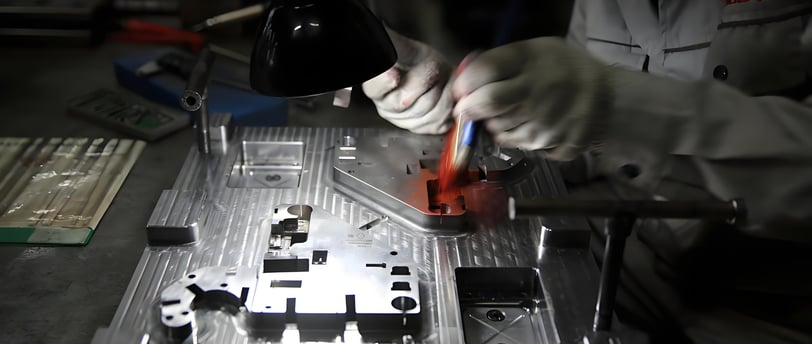How to Choose the Right Material for Stamping Dies
1/19/2025


Understanding Stamping Dies and Their Purpose
Stamping dies are essential tools used in various manufacturing and crafting processes, designed to create precise shapes and designs from different materials. They function by applying pressure to a material, typically metal or plastic, using a hardened tool that cuts, forms, or sets shapes in the desired form. The design and complexity of stamping dies can vary considerably depending on their application, making them integral to industries such as automotive, electronics, and jewelry.
In the automotive industry, stamping dies play a vital role in the fabrication of numerous components, including body panels and brackets. These components must meet strict specifications for safety and performance, and stamping dies ensure that the components are produced with accuracy and consistency. Electronic devices also benefit from stamping dies, which are used to create small, intricate parts like connectors and housings that require precise workmanship to fit together seamlessly.
Moreover, the jewelry industry uses stamping dies to shape and engrave delicate designs on metal pieces, allowing artisans to create unique and detailed items. The process is both efficient and versatile, enabling the mass production of intricate designs that might be challenging to achieve by hand.
There are several stamping processes, including die stamping, progressive stamping, and deep drawing, each suited for different tasks and materials. The choice of stamping die material is fundamental in achieving the desired results. Factors such as the type of material being stamped, the volume of production, and the intricacy of the design significantly influence this decision. Selecting the right stamping die material is crucial for optimizing production efficiency and ensuring the longevity and performance of the die itself.
Key Factors to Consider When Selecting Die Materials
When selecting materials for stamping dies, several crucial factors must be considered to ensure optimal performance and longevity. The first factor is hardness, which plays a significant role in the die's ability to withstand the pressures and impacts during the stamping process. Harder materials, such as high-speed steel and carbide, offer increased durability but may also be more challenging to machine.
Wear resistance is another critical property to look for in die materials. Stamping dies frequently encounter friction and abrasive conditions, leading to wear over time. Selecting materials with high wear resistance can extend the life of the die, reducing the frequency of replacements and associated downtime. Materials such as tool steel and certain alloys are known for excellent wear resistance, making them suitable choices for heavy stamping applications.
Machinability refers to how easily a material can be shaped or cut into the desired form. This is essential during the manufacturing process, as complicated die designs require materials that can be efficiently machined without compromising strength. Some materials, like aluminum, offer superior machinability but may lack the hardness required for specific applications. It's important to evaluate the trade-offs between machinability and other important properties.
Thermal stability is another key consideration. Stamping operations generate significant heat, and materials need to perform reliably at elevated temperatures. Selecting a material with high thermal stability will prevent deformation or failure of the die under extreme conditions, which is vital for maintaining consistency and quality in production.
Finally, cost-effectiveness must be taken into account when selecting die materials. While higher-quality materials may offer better performance, budget constraints often necessitate a balance between quality and cost. By weighing each of these factors—hardness, wear resistance, machinability, thermal stability, and cost—manufacturers can make informed decisions that best suit their specific stamping needs.
Common Materials Used for Stamping Dies
Stamping dies are crucial components in various manufacturing processes, and selecting the appropriate material can significantly impact performance, durability, and overall production efficiency. Among the most commonly used materials for stamping dies are tool steel, carbide, aluminum, and specialized materials. Each has its distinct properties that cater to different stamping operations.
Tool steel is one of the predominant choices for stamping dies due to its excellent hardness and wear resistance. Common grades like D2, A2, and O1 exhibit varying levels of toughness and workability, making them suitable for a range of applications. D2 tool steel, for instance, is ideal for high-volume production runs, while A2 offers better ductility and is favored in applications requiring intricate shapes.
Carbide is another option that provides exceptional hardness and wear resistance, often favored for high-precision dies. Tungsten carbide dies are incredibly durable and can withstand extreme conditions, making them suitable for metal stamping operations. The downside is that carbide can be quite brittle, and the cost is generally higher than that of tool steel. Thus, it is essential to consider the specific demands of the stamping process before opting for carbide dies.
Aluminum, although softer than tool steel or carbide, is gaining popularity, especially in prototyping and low-volume applications. Aluminum stamping dies are lightweight and easier to machine, allowing for faster production times. However, they may not endure the same stress levels as harder materials, thus limiting their use to less demanding applications.
Finally, specialty materials, which include composites and high-performance polymers, are becoming increasingly popular. These materials can be engineered for specific applications and offer a balance of weight, strength, and cost-effectiveness. They may be suitable for niche applications where traditional metals might not perform optimally.
Understanding the unique characteristics of these materials is crucial for selecting the right stamping die for your project. The choice ultimately depends on the production requirements, budget, and expected lifespan of the die in question.
Best Practices for Die Material Selection and Maintenance
Selecting the appropriate materials for stamping dies is crucial for achieving optimal performance and longevity. The first step involves assessing the operational environment where the dies will be used. Factors such as the types of materials being stamped, production volume, and stamping speed should be evaluated to determine the most suitable die material. It is essential to choose a material that can withstand the stresses and wear associated with your specific application. For instance, high-strength steel alloys are often preferred for high-volume production due to their durability, while carbide dies may be more suitable for intricate designs as they are resistant to abrasive wear.
Once the die material has been selected, regular inspections play a vital role in maintenance. Conducting routine checks for signs of wear, chipping, or surface degradation helps in identifying potential issues before they escalate into significant problems. Keeping detailed records of inspections can also assist in anticipating when a die may need repair or replacement, thus minimizing downtime and production disruptions.
Implementing preventive maintenance strategies is equally important for extending the lifespan of stamping dies. This may include routine cleaning to remove debris and lubricants that can accumulate during the stamping process. Moreover, establishing a scheduled maintenance routine ensures that the dies are consistently monitored and serviced as needed. Proper storage and handling of die materials are critical in preventing damage. Using protective covers and maintaining controlled storage environments can help safeguard against corrosion and physical damage. By adopting these best practices for die material selection and maintenance, manufacturers can not only protect their investments in stamping dies but also enhance overall production efficiency, reducing costs associated with excessive die wear and unexpected failures.
